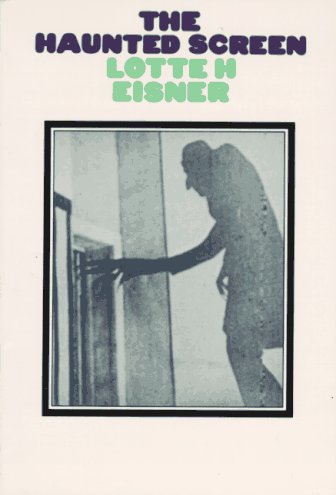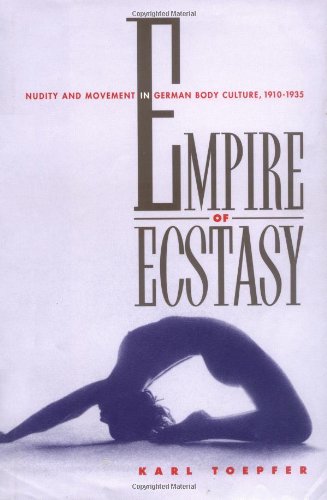Lotte H. Eisner: The Haunted Screen: Expressionism in German Cinema and the Influence of Max Reinhardt (1952/1969)
Filed under book | Tags: · 1910s, 1920s, cinema, expressionism, film, film criticism, film history, germany, romanticism, theatre

The expressionist era of German cinema began at the end of the First World War and ended shortly after the coming of sound. From The Cabinet of Dr. Caligari onwards the principal films of this period were characterized by two influences: literary Expressionism, and the innovations of the theatre directors of this period, in particular Max Reinhardt. This book demonstrates the connection between German Romanticism and the cinema through Expressionist writings. It discusses the influence of the theatre: the handling of crowds; the use of different levels, and of selective lighting on a predominately dark stage; the reliance on formalized gesture; the innovation of the intimate theatre. Against this background the principal films of the period are examined in detail. The author explains the key critical concepts of the time, and surveys not only the work of the great directors, such as Fritz Lang and F. W. Murnau, but also the contribution of their writers, cameramen, and designers.
First published as L’Écran démoniaque. Influence de Max Reinhardt et de l’Expressionisme, 1952; revised 1965.
Translated by Roger Greaves
Publisher Thames and Hudson, London, 1969
360 pages
via knappen
Review (Richard B. Byrne, Cinema Journal, 1970)
PDF (116 MB)
Comment (0)Asja Lacis: Revolutionär im Beruf, Berichte über proletarisches Theater, über Meyerhold, Brecht, Benjamin und Piscator (1971) [German]
Filed under book | Tags: · 1910s, 1920s, 1930s, avant-garde, experimental theatre, germany, theatre, weimar republic

A memoir of the theatre director, actress and pedagogue Asja Lacis follows her life and theatre work in revolutionary Russia and the Weimar Republic, and offers commentary on work and ideas of avant-garde artists and groups of the time. Lacis was a personal friend and collaborator of Walter Benjamin and Bertolt Brecht (whom she introduced to each other), Erwin Piscator and Bernhard Reich, among others. She was a primary influence in moving Benjamin to the Left. Along with Reich she was also responsible for making Brecht known in the Soviet Union.
Edited by Hildegard Brenner
Publisher Rogner & Bernhard, Munich, 1971
132 pages
via richardb
Review (Patty Lee Parmalee, New German Critique, 1975, in English)
The Writing of Asja Lacis (Susan Ingram, New German Critique, 2002, 19 pp, in English)
Commentary (Susan Ingram, 2003)
PDF (no OCR)
Comment (0)Karl Toepfer: Empire of Ecstasy: Nudity and Movement in German Body Culture, 1910-1935 (1997)
Filed under book | Tags: · 1910s, 1920s, 1930s, avant-garde, ballet, bauhaus, body, dance, expressionism, germany, photography, theatre, weimar republic

Empire of Ecstasy offers an interpretation of the explosion of German body culture between the two wars—nudism and nude dancing, gymnastics and dance training, dance photography and criticism, and diverse genres of performance from solo dancing to mass movement choirs. Karl Toepfer presents this dynamic subject as a vital and historically unique construction of “modern identity.”
The modern body, radiating freedom and power, appeared to Weimar artists and intelligentsia to be the source of a transgressive energy, as well as the sign and manifestation of powerful, mysterious “inner” conditions. Toepfer shows how this view of the modern body sought to extend the aesthetic experience beyond the boundaries imposed by rationalized life and to transcend these limits in search of ecstasy. With the help of much unpublished or long-forgotten archival material (including many little-known photographs), he investigates the process of constructing an “empire” of appropriative impulses toward ecstasy.
Toepfer presents the work of such well-known figures as Rudolf Laban, Mary Wigman, and Oskar Schlemmer, along with less-known but equally fascinating body culture practitioners. His book is certain to become required reading for historians of dance, body culture, and modernism.
Publisher University of California Press, 1997
ISBN 0520918274, 9780520918276
422 pages
PDF’d HTML, HTML (from the publisher)
See also Mel Gordon, Voluptuous Panic: The Erotic World of Weimar Berlin, 2000–.
Comment (0)
